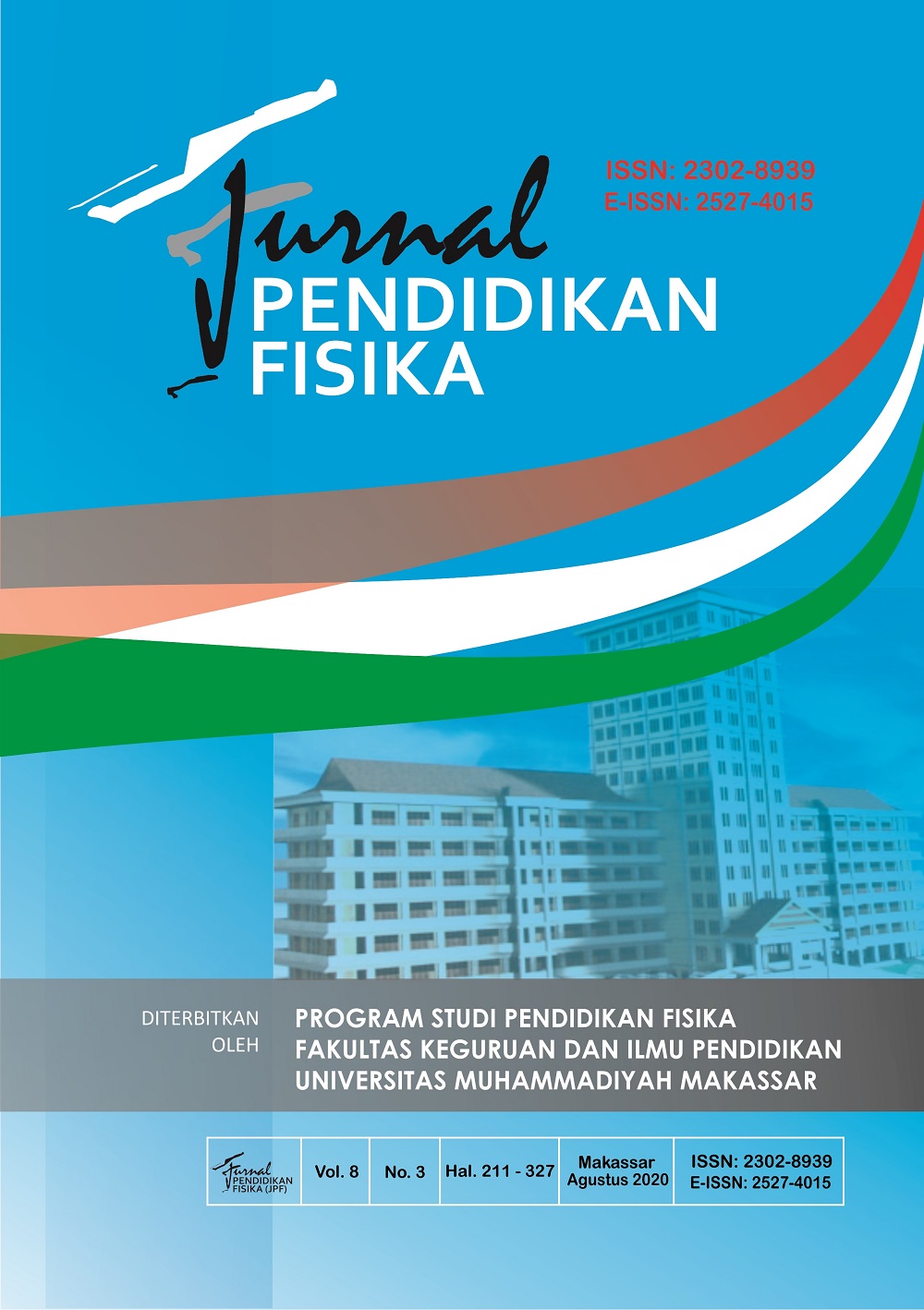Project Based Learning E-Module to Teach Straight-Motion Material for Prospective Physics Teachers
DOI: https://doi.org/10.26618/jpf.v8i3.3442
E-Module, Project Based Learning, Straight Motion
Abstract
This research is a research development using the ADDIE model. The product developed in this research is project based learning E-module. The stages that were passed in this study were Analysis, Design, Develop, Implement, and Evaluate. The research instrument was in the form of an E-module validity test sheet, an E-module readability sheet and an E-module user response questionnaire. Data analysis techniques using the feasibility test E-Module, E-Module Readability Test and the response of the use of E-Module. The conclusion of the study is that the E-module based on project based learning using the ADDIE model developed is suitable for use with revisions with an average percentage given by the validator of 84.5%. The results of the E-module readability test based on project based learning with an average percentage of 82.9%, which means the reader is at an independent or free level, which means the reader understands the contents of the E-Module reading that was developed. Overall students responded very well with an average percentage of 87.1% of the E-Module based on project based learning that was developed.
References
Krisnayana, I. K. A., Putrama, I. M., & Divayana, D. G. H. (2018). Pengembangan E-Modul Berbasis Project Based Learning (PjBL) Mata Pelajaran Visual Effect Kelas XI Multimedia Di SMK TI Bali Global Singaraja. KARMAPATI (Kumpulan Artikel Mahasiswa Pendidikan Teknik Informatika), 7(2), 104-112.
Daryanto. (1993). Media Visual untuk Pengajaran Teknik. Bandung: Tarsito
Zainul, R. and Oktavia, B., 2018. Pengenalan Dan Pengembangan E-Modul Bagi Guru-Guru Anggota Mgmp Kimia Dan Biologi Kota Padang Panjang. https://osf.io/preprints/inarxiv/yhau2/
Bell, S. (2010). Project-based Learning for the 21st century: Skills for the future. The Clearing House, 83(2), 39-43.
Luthvitasari, N., DP, N. M., & Linuwih, S. (2013). Implementasi Pembelajaran Berbasis Proyek pada Keterampilan Berpikir dan Kemahiran Generik Sains. Innovative Journal of Curriculum and Educational Technology, 2(1).
Novianto, N. K., Masykuri, M., & Sukarmin, S. (2018). Pengembangan Modul Pembelajaran Fisika Berbasis Proyek (Project Based Learning) Pada Materi Fluida Statis Untuk Meningkatkan Kreativitas Belajar Siswa Kelas X Sma/Ma. Inkuiri: Jurnal Pendidikan IPA, 7(1), 81-92.
Yalcin, S., A., Turgut, U & Buyukkasap, E. (2009).The Effect of Project Based Learning onScience Undergraduates’ Learning ofElectricity, Attitude towards Physics andScientific Process Skills. InternationalOnline Journal of Education Sciences. 1
TIM UNY. 2016. Modul Vs E-Modul. (http://staffnew.uny.ac.id/upload/198401312014042002/pengabdian/Modul%20Vs%20E-Module.pdf) diakses 16 April 2020
Wijayanto, W., & Zuhri, M. S. (2014, November). Pengembangan E-Modul Berbasis Flip Book Maker dengan Model Project BAsed Learning untuk Mengembangkan kemampuan Pemecahan Masalah Matematika. In MATHEMATICS AND SCIENCES FORUM 2014
Sugiyanto, Doni, dkk. Modul Virtual:Multimedia Flipbook Dasar Teknik Digital. INVOTEC, Volume IX, No.2, Agustus 2013: 101-116
Suarsana, I. M. (2013). Pengembangan e-modul berorientasi pemecahan masalah untuk meningkatkan keterampilan berpikir kritis mahasiswa. JPI (Jurnal Pendidikan Indonesia), 2(2).
Ridwan, M. 2012. Keterbacaan wacana Dalam buku Teks Bahasa Dan Sastra Indonesia untuk SMP/MTs kelas VIII Karangan Wahono terbitan CV Gita Perdana Tahun 2010. Jurnal Kata (Bahasa, Sastra, dan Pembelajarannya), 1(2): 14-27.
Zulkarnain, A., Kadaritna, N., & Tania, L. (2015). Pengembangan e-Modul Teori Atom Mekanika Kuantum Berbasis WEB dengan Pendekatan Saintifik. Jurnal Pendidikan dan Pembelajaran Kimia, 4(1), 222-235.
Prastowo, Andi. 2012. Panduan Kreatif Membuat Bahan Ajar Inovatif. Jogjakarta: Diva Press.
Downloads
Additional Files
Published
How to Cite
Issue
Section
License
Copyright:
Authors who publish with this journal agree to the following terms:
1. Authors retain copyright and grant the journal right of first publication with the work simultaneously licensed under a Creative Commons Attribution-ShareAlike 4.0 International License that allows others to share the work with an acknowledgement of the work's authorship and initial publication in this journal.
2. Authors are able to enter into separate, additional contractual arrangements for the non-exclusive distribution of the journal's published version of the work (e.g., post it to an institutional repository or publish it in a book), with an acknowledgement of its initial publication in this journal.
3. Authors are permitted and encouraged to post their work online (e.g., in institutional repositories or on their website) prior to and during the submission process, as it can lead to productive exchanges, as well as earlier and greater citation of published work.
Licence:
Authors are free to:
1. Share: Copy and redistribute the material in any medium or format
2. Adapt: Remix, transform, and build upon the material for any purpose, even commercially.
The licensor cannot revoke these freedoms as long as the authors follow the license terms, which include the following:
1. Attribution: You must give appropriate credit, provide a link to the license, and indicate if changes were made. You may do so in any reasonable manner, but not in any way that suggests the licensor endorses you or your use.
2. ShareAlike: If you remix, transform, or build upon the material, you must distribute your contributions under the same license as the original.
3. No additional restrictions: You may not apply legal terms or technological measures that legally restrict others from doing anything the license permits.
Jurnal Pendidikan Fisika is licensed under a Creative Commons Attribution-ShareAlike 4.0 International License.






